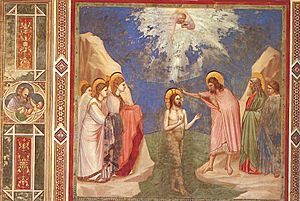Feast of the Baptism of the Lord facts for kids
The Feast of the Baptism of the Lord is a special day for Christians. It remembers when Jesus was baptized in the Jordan River by John the Baptist. This event is very important in the Christian faith.
This feast is also sometimes called Theophany. It was first celebrated along with Epiphany. Epiphany remembers three things: the wise men visiting Jesus, Jesus's baptism, and a wedding miracle Jesus performed. Over time, in Western churches, the Baptism of the Lord became its own separate celebration.
Most Catholic, Anglican, and Lutheran churches celebrate it. They usually do this on the first Sunday after Epiphany (January 6). Some Lutheran churches celebrate it on the Sunday before Lent. This Sunday is also known as Quinquagesima.
Contents
Celebrating the Baptism of Jesus
This section explains how different Christian churches celebrate the Feast of the Baptism of the Lord. It is a time to remember Jesus's important baptism.
Eastern Christian Churches
In the Eastern Orthodox and Eastern Catholic churches, the Baptism of the Lord is a big part of Epiphany. They celebrate it all together on January 6.
Some of these churches use the old Julian calendar. For them, January 6 on their calendar falls on January 19 of the modern Gregorian calendar. This is why their celebration date might seem different.
Western Christian Churches
In Western Christian churches, the Baptism of the Lord is often a separate feast day.
Roman Catholic Church
The Roman Catholic Church now celebrates the Baptism of the Lord as its own feast. It used to be one of three events remembered on Epiphany. But the visit of the wise men became the main focus of Epiphany.
In 1955, Pope Pius XII made the Baptism of the Lord a separate day to remember. Later, Pope Paul VI set its date. It is now celebrated on the first Sunday after January 6. This means it can be as early as January 7 or as late as January 13. If Epiphany is celebrated on a Sunday (January 7 or 8), the Baptism of the Lord is on the next Monday.
Pope John Paul II started a tradition for this feast. On this day, the Pope baptizes babies in the Sistine Chapel.
Lutheran Churches
In the past, Lutheran churches celebrated the Baptism of the Lord around the same time as Epiphany.
Today, many Lutheran churches celebrate it as a separate feast. It is usually on the first Sunday after Epiphany.
Some Lutheran churches, especially those with Scandinavian roots, celebrate it differently. They celebrate the Baptism of Christ on the last Sunday before Lent. This Sunday is called Quinquagesima Sunday. This timing connects it closely to the story of Jesus's temptation, which follows his baptism.
Anglican Communion
In the Church of England, Epiphany can be on January 6 or a Sunday between January 2 and 8. If Epiphany is on a Sunday on or before January 6, the Baptism of Christ is on the next Sunday. If Epiphany is on January 7 or 8, the Baptism of Christ is on the next Monday.
In the Episcopal Church in the USA, Epiphany is always on January 6. The Baptism of the Lord is always on the Sunday after that. This feast is seen as closely connected to Epiphany.
Methodist Churches
Traditionally, Methodist Churches have a special service on New Year's Eve. This service is called a covenant renewal liturgy.
Many Methodist churches celebrate the Feast of the Baptism of the Lord. They often do this on the second Sunday in January. This is after the Epiphany feast has already happened.


